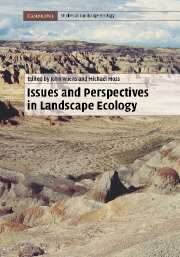Book contents
- Frontmatter
- Contents
- List of contributors
- Preface
- PART I Introductory perspectives
- PART II Theory, experiments, and models in landscape ecology
- PART III Landscape patterns
- PART IV Landscape dynamics on multiple scales
- PART V Applications of landscape ecology
- 18 Landscape ecology as the broker between information supply and management application
- 19 Farmlands for farming and nature
- 20 Landscape ecology and forest management
- 21 Landscape ecology and wildlife management
- 22 Restoration ecology and landscape ecology
- 23 Conservation planning at the landscape scale
- 24 Landscape conservation: a new paradigm for the conservation of biodiversity
- 25 The “why?” and the “so what?” of riverine landscapes
- PART VI Cultural perspectives and landscape planning
- PART VII Retrospect and prospect
- Index
- Plate section
- References
22 - Restoration ecology and landscape ecology
from PART V - Applications of landscape ecology
Published online by Cambridge University Press: 20 November 2009
- Frontmatter
- Contents
- List of contributors
- Preface
- PART I Introductory perspectives
- PART II Theory, experiments, and models in landscape ecology
- PART III Landscape patterns
- PART IV Landscape dynamics on multiple scales
- PART V Applications of landscape ecology
- 18 Landscape ecology as the broker between information supply and management application
- 19 Farmlands for farming and nature
- 20 Landscape ecology and forest management
- 21 Landscape ecology and wildlife management
- 22 Restoration ecology and landscape ecology
- 23 Conservation planning at the landscape scale
- 24 Landscape conservation: a new paradigm for the conservation of biodiversity
- 25 The “why?” and the “so what?” of riverine landscapes
- PART VI Cultural perspectives and landscape planning
- PART VII Retrospect and prospect
- Index
- Plate section
- References
Summary
The recent history of the world has been one of a dramatic increase in the incidence of human-induced disturbances as humans utilize an increasing proportion of the earth's surface in some way or another and appropriate an increasing amount of the earth's productive capacity and natural resources (Vitousek et al., 1997). Human modification has led in many cases to increasing degradation of ecosystem components, resulting in a decline in the value of the ecosystem, either for production or for conservation purposes. This has been met with an increasing recognition that measures need to be taken to halt or reverse this degradation, and hence the importance of restoration or repair of damaged ecosystems is increasing (Dobson et al., 1997; Hobbs, 1999).
Restoration ecology is the science behind attempts to repair damaged ecosystems. Here I provide a brief outline of recent developments in the field of restoration ecology, and highlight where I think a strong synergy exists between restoration ecology and landscape ecology. The material presented in this chapter is based in part on Hobbs and Norton (1996), Hobbs (1999), and McIntyre and Hobbs (1999, 2000)
What is restoration ecology?
The term “ecological restoration” covers a wide range of activities involved with the repair of damaged or degraded ecosystems. An array of terms has been used to describe these activities including restoration, rehabilitation, reclamation, reconstruction, and reallocation.
- Type
- Chapter
- Information
- Issues and Perspectives in Landscape Ecology , pp. 217 - 229Publisher: Cambridge University PressPrint publication year: 2005
References
- 3
- Cited by



